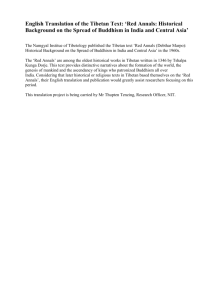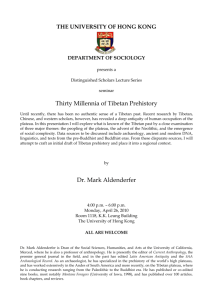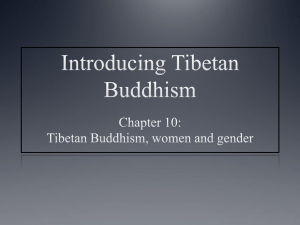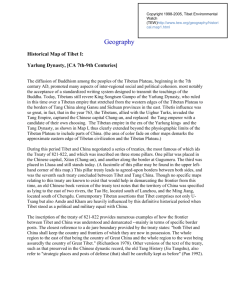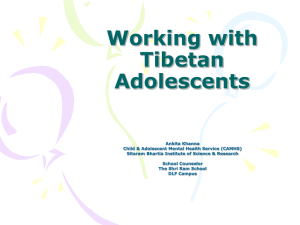Information provided by James B. Robinson, associate professor, world religions,
advertisement
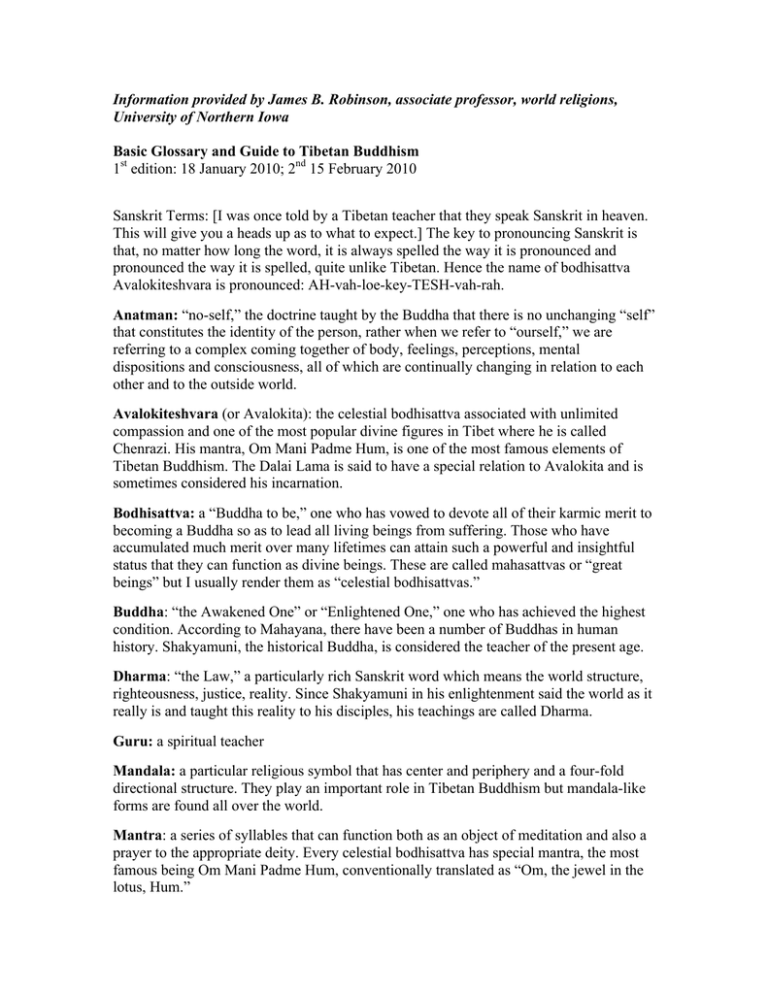
Information provided by James B. Robinson, associate professor, world religions, University of Northern Iowa Basic Glossary and Guide to Tibetan Buddhism 1st edition: 18 January 2010; 2nd 15 February 2010 Sanskrit Terms: [I was once told by a Tibetan teacher that they speak Sanskrit in heaven. This will give you a heads up as to what to expect.] The key to pronouncing Sanskrit is that, no matter how long the word, it is always spelled the way it is pronounced and pronounced the way it is spelled, quite unlike Tibetan. Hence the name of bodhisattva Avalokiteshvara is pronounced: AH-vah-loe-key-TESH-vah-rah. Anatman: “no-self,” the doctrine taught by the Buddha that there is no unchanging “self” that constitutes the identity of the person, rather when we refer to “ourself,” we are referring to a complex coming together of body, feelings, perceptions, mental dispositions and consciousness, all of which are continually changing in relation to each other and to the outside world. Avalokiteshvara (or Avalokita): the celestial bodhisattva associated with unlimited compassion and one of the most popular divine figures in Tibet where he is called Chenrazi. His mantra, Om Mani Padme Hum, is one of the most famous elements of Tibetan Buddhism. The Dalai Lama is said to have a special relation to Avalokita and is sometimes considered his incarnation. Bodhisattva: a “Buddha to be,” one who has vowed to devote all of their karmic merit to becoming a Buddha so as to lead all living beings from suffering. Those who have accumulated much merit over many lifetimes can attain such a powerful and insightful status that they can function as divine beings. These are called mahasattvas or “great beings” but I usually render them as “celestial bodhisattvas.” Buddha: “the Awakened One” or “Enlightened One,” one who has achieved the highest condition. According to Mahayana, there have been a number of Buddhas in human history. Shakyamuni, the historical Buddha, is considered the teacher of the present age. Dharma: “the Law,” a particularly rich Sanskrit word which means the world structure, righteousness, justice, reality. Since Shakyamuni in his enlightenment said the world as it really is and taught this reality to his disciples, his teachings are called Dharma. Guru: a spiritual teacher Mandala: a particular religious symbol that has center and periphery and a four-fold directional structure. They play an important role in Tibetan Buddhism but mandala-like forms are found all over the world. Mantra: a series of syllables that can function both as an object of meditation and also a prayer to the appropriate deity. Every celestial bodhisattva has special mantra, the most famous being Om Mani Padme Hum, conventionally translated as “Om, the jewel in the lotus, Hum.” Nirvana: the complete extinction of the passions, meaning liberation from the forces that drive the life of suffering. Prajna-paramita: the “perfection of wisdom,” literally “the Wisdom that goes to the Other Shore (i.e. Nirvana)” which can refer to a] supreme enlightenment; 2] a set of scriptures that describe the viewpoint that enables one to achieve such perfection of wisdom; 3] a goddess who is mythic embodiment of enlightenment—since both prajna and paramita are feminine gender in Sanskrit Sambhoga-kaya: the “altogether blessed body,” the glorified spiritual body of a Buddha manifest in high heavenly paradises and accessible by ecstatic vision. Sangha: the Buddhist Community divided into four parts: monks, nuns, laymen, laywomen. Sutra: a “sermon” of the Buddha. Tantra: a text of esoteric or secret teachings, an important and distinctive part of Tibetan Buddhism. Upaya: “effective action” or “skill in means,” a characteristic of a bodhisattva or a Buddha. It is often considered the male counterpart to prajna or wisdom. Yoga: any structured spiritual practice. It is a non-denominational term and can refer to a wide variety of specific disciplines. Tibetan Terms—transliteration on the left, pronunciation on the right Bon: a religious tradition with roots in the indigenous religion of Tibet but not identical to it – a lot can happen in a thousand years. Its practitioners are called the Bonpo and sometimes more informally but inaccurately called “the Black Hats.” The term “Bon” is said to be equivalent to the Sanskrit term “Dharma.” While having strong animistic and shamanistic elements to it, acknowledging both good and evil spirits, Bon considers itself an organized body of teachings revealed by an enlightened master, Shen-Rab, who was born before the time of Shakyamuni somewhere in Central Asia. It centers on a vast pantheon of local spirits and gods, many of whom have also been incorporated into Buddhism. Dorje/Dorje: the Tibetan rendering of the Sanskrit word “vajra” which can be translated either as “diamond” or “thunderbolt.” Both translations are appropriate. A ritual rdorje is a multi-pronged instrument, symmetrical on the two sides. It is usually paired with a bell, a drilbu. The dorje represents the effective life in the world (upaya) and the bell represents wisdom, which is the recognition of emptiness. Ge-lugs-pa/Gelugpa: the principal school of Tibetan Buddhism, established by the great Tibetan master, Tsong Khapa. Its name means “the Virtuous Ones.” It is sometimes called “the Yellow Hat” sect. The Gelugpas are noted for their insistence upon firm monastic disciplines, study of both sutra and tantra and an emphasis upon scholarship, logic and monastic discipline. While they did not invent the principle of reincarnated successors, they brought the principle into prominence. Ka’-rGyud-pa/Kargyupas: literally “those who follow transmitted teachings.” This transmission is associated with the lineage of Tilopa, Naropa, two Indian masters then Marpa “the Translator,” considered the actual founder of the school. Kargyupas emphasize the practice of yoga more than any other sect. Its most famous figure is Milarepa, the disciple of Marpa, and one of the most popular figures in Tibetan lore. Milarepa’s successor was Gampopa. After him, the Kargyupas split up into a number of different sub-sects. The foremost of these are the Karmapas who are prominent in Bhutan and have established monasteries in the US as well. Kra-shis-bDe-legs/Tashi Delek: “Good Fortune,” a Tibetan greeting. Kyil-‘khor/kyilkhor: a mandala. La-ma/Lama: the Tibetan rendering of the Sanskrit “guru”; a spiritual teacher. The lama is central to Tibetan Buddhism, so much so that a now somewhat archaic usage of “Lamaism” was once used to describe Tibetan Buddhism as a distinct entity Lhasa – literally “the land of the gods,” the capital of Tibet. Mi-la-ras-pa/Milarepa: the student of Marpa and regarded as one of Tibet’s greatest poets and one of the most beloved figures in Tibetan history. At first, he had dabbled in black magic but repented when he caused the death of a number of his family. He became a student of Marpa, achieving high spiritual estate. He wandered through Tibet, singing songs and preaching the Dharma in language everyone could understand. Many of his songs are still sung today. lNga-pa Chen-po, “the Great Fifth,” The 5th Dalai Lama (born 1617) becomes the ruler of Tibet in 1642. He is one of the greatest political figures in Tibetan history. He organized a very efficient administration and Tibet enters into a period of considerable social development. Lhasa became the capital for all Tibet and he began building the Potala. Nying-ma-pa: “the Ancient Ones,” the oldest Buddhist school in Tibet. It was founded by Guru Rimpoche or Padma Sambhava and its practitioners are some-times called “the Red Hats.” It gives primary emphasis to Tantric teachings. Many of its teachers are householders and thus are not under the vow of celibacy. According to Nyingmapa tradition, Guru Rimpoche buried special secret texts called Termas, “treasures” which are to be discovered later by reincarnations of his disciples when the time is ripe. This has provided a source for progressive revelation. While the Nyingmapas have lost ground to the Gelugpas in central Tibet, they are still important in outlying regions. Sa-skya-pa/Sakyapas: a school of Tibetan Buddhism, deriving its name from its main monastery. It began with close connections to the Nyingmapas but then moved in the direction of greater study of the sutras and greater emphasis upon monastic discipline. The Sakyapas were given secular dominion over Tibet by Kubulai Khan as a reward for the services of Phagspa, a Tibetan scholar who served as a religious councilor to the Khan. They declined in political importance afterward but they continue as a lineage to the present day. bSam-yas/Sam-ye – a monastery built outside of Lhasa; the first Buddhist monastic institution. It was the scene of a famous debate in 792 between the Indian pandita Kamalashila and the Chinese Ch’an (Zen) monk Mahayana Huashang. Kamalashila decisively wins the debate and the Tibetans reject the Chinese interpretation of Buddhism in favor of the Indian model. Ter-ma/terma: a “treasure text,” said to have been composed by Padmasambhava and hidden away until an auspicious time for it to be revealed. They are said to be found by Guru Rimpoche’s reincarnated disciples (Tertons). In historical terms, they provide the basis for a process of “progressive revelation.”
